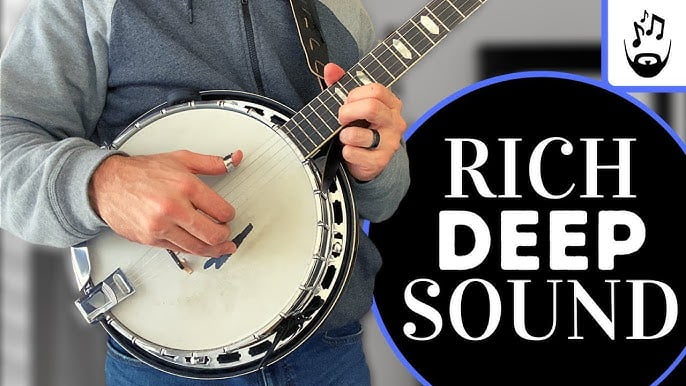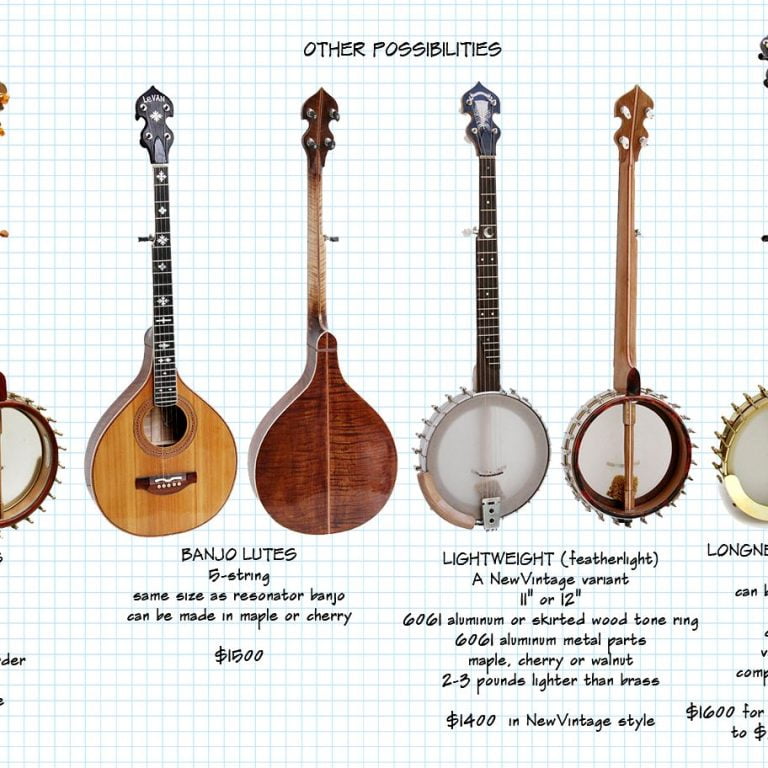There are five main tunings for tunings 5 string banjo: G-Tuning, C-Tuning, D-Tuning, Double-C-Tuning, and Open-G-Tuning. Each tuning produces a unique sound and is suitable for different styles of music.
G-Tuning is the most common, with the strings tuned to G-D-G-B-D. C-Tuning and D-Tuning are often used in bluegrass music, while Double-C-Tuning is popular for playing old-time fiddle tunes. Open-G-Tuning is commonly used in folk, blues, and slide guitar music.
Lastly, the choice of tuning depends on the player’s music style and personal preference. Understanding the characteristics of each tuning and how it relates to different musical genres can help banjo players find their ideal sound.
Historical Evolution
Throughout its historical evolution, the 5 string banjo has undergone various tunings, reflecting the changing musical styles and needs of the players. From the early tunings to the modern adaptations, the tunings of the 5 string banjo offer a window into the instrument’s rich history and cultural significance.
Early 5 String Banjo Tunings
The early tunings of the 5 string banjo were influenced by African and Afro-Caribbean musical traditions that emphasized rhythmic patterns and syncopated melodies. One of the most well-known early tunings is g-D-G-B-D, commonly referred to as “open G” tuning. This tuning allowed for the creation of vibrant, percussive sounds that complemented the banjo’s distinct timbre. Another significant early tuning is the a-D-G-B-D tuning, often associated with the minstrel banjo tradition and popularized during the 19th century.
Evolution And Adaptations
As the banjo’s role in American music evolved, so too did its tunings. With the emergence of bluegrass and old-time music in the early 20th century, new tunings such as g-C-G-B-D (known as “sawmill” tuning) and g-C-G-C-D offered musicians the ability to play complex melodies and intricate chord progressions. These adaptations reflected the changing musical landscape and the need for tunings that could accommodate a wider range of musical expression.
Open G Tuning
Open G tuning is a popular five-string banjo tuning that is used in a variety of musical styles, particularly in bluegrass music. This tuning is favored for its bright and lively sound, making it a versatile option for both traditional and contemporary banjo playing. Understanding the characteristics and popular songs utilizing this tuning can help banjo enthusiasts explore new musical possibilities.
Description And Characteristics
Open G tuning, also known as “G tuning,” is an alternative tuning for the five-string banjo. In this tuning, the banjo is tuned to a G major chord, with the strings tuned to the notes G, D, G, B, and D from the lowest to the highest string. The open G tuning creates a resonant and open sound, allowing players to achieve unique chord voicings and melodic possibilities. The simplicity and versatility of this tuning make it a popular choice for banjoists of all skill levels.
Popular Songs Utilizing This Tuning
“Cripple Creek” by Earl Scruggs
“Foggy Mountain Breakdown” by Earl Scruggs
“Dueling Banjos” by Arthur Smith and Don Reno
“Little Maggie” by Ricky Skaggs
Double C Tuning
Double C tuning, also known as GCGCD, is a popular 5 string banjo tuning that is commonly used in old-time music. This tuning is well-suited for playing in the key of C and its modal counterparts, as well as for accompanying fiddle and other stringed instruments. The distinct sound of Double C tuning is characterized by its rich, resonant tones, making it a favorite among traditional banjo players.
Description And Characteristics
Double C tuning is identified by the open strings which are tuned to G, C, G, C, and D, from the 5th to the 1st string, respectively. This tuning creates a deep, resonant sound that suits traditional folk and old-time music styles. It allows for melodic playing and is particularly well-suited for accompanying vocal melodies and fiddle tunes.
Pros And Cons
Pros:
- Well-suited for playing in the key of C and its modal counterparts
- Rich, resonant tones ideal for traditional banjo music
- Excellent for accompanying vocal melodies and fiddle tunes
Cons:
- Less versatile for playing in keys outside of C
- May require adjusting playing techniques for different styles of music
Sawmill Tuning
The Sawmill Tuning is a popular 5 string banjo tuning that is often associated with old-time Appalachian music. This tuning, also known as the G Modal or Mountain Minor tuning, has a distinctive and evocative sound that adds a unique flavor to traditional banjo music.
Description And Characteristics
The Sawmill Tuning is characterized by the open G tuning with the 5th string drone tuned to a D note. This creates a haunting and modal sound that is reminiscent of the Appalachian mountains and the old-time music traditions of the region. The tuning is as follows:
String Note
1st (D) D
2nd (B) D
3rd (G) D
4th (D) G
5th (drone string) D
Unique Applications
The Sawmill Tuning is particularly well-suited to playing traditional Appalachian music, old-time fiddle tunes, and songs with a modal or haunting quality. Its evocative sound adds a unique dimension to banjo music, allowing players to create a melancholic and atmospheric vibe that is perfect for storytelling through music.
D Tuning
The D tuning is a popular tuning for the 5 string banjo that offers a bright and lively sound. This tuning, also known as “Double C” tuning, is commonly used in traditional bluegrass music and provides a unique and distinct character to the banjo’s sound.
Description And Characteristics
In D tuning, the banjo is tuned to open D major chord, which is a popular tuning for many banjo players due to its versatility and bright, cheerful sound. This tuning is achieved by tuning the strings to D2, B1, G1, D1, G2 from the 4th to 1st string, respectively.
Musical Styles That Use This Tuning
The D tuning is widely used in traditional bluegrass music, as well as in old-time, folk, and country music. It is known for its ability to create a cheerful and energetic sound that complements the lively nature of these musical genres.
Open D Tuning
Open D tuning is a popular string banjo tuning known for its resonant and rich sound. The tuning is created by tuning the five strings of the banjo to a D major chord, resulting in a deep and melodious tone that enhances the instrument’s versatility. Open D tuning is widely used in various musical genres, including folk, bluegrass, and country. Let’s delve into a detailed exploration of Open D tuning and its unique characteristics.
Description And Origin
Open D tuning, also known as “D tuning,” is structured by tuning the banjo strings to the notes D, A, D, F#, and A. This arrangement forms a D major chord when strummed open, creating a powerful and resonant sound. Due to its open chord structure, Open D tuning enables banjo players to produce rich, full-bodied chords with minimal effort, making it a favored option for both beginners and seasoned musicians. The origin of Open D tuning can be traced back to early American folk and blues music, where its deep, vibrant tones contributed to its widespread adoption.
Comparisons To Other Tunings
Open D tuning is distinct from other banjo tunings such as Standard G tuning and Double C tuning. Unlike Standard G tuning, which is prevalent in bluegrass music, Open D tuning offers a lower, more resonant tone that complements a wider range of musical styles. Additionally, Open D tuning differs from Double C tuning in its chord versatility, enabling banjo players to effortlessly produce rich, open chords that enhance the overall tonal quality of the instrument. The unique harmonies and tonal depth of Open D tuning set it apart from other banjo tunings, making it a valuable addition to a musician’s repertoire.
Drop C Tuning
Drop C tuning is a popular 5 string banjo tuning that is known for its deep, rich sound. In drop C tuning, the strings are tuned to C-G-C-G-C, with the lowest string (5th string) dropped down to C from the standard G tuning. This tuning is particularly favored by folk and bluegrass musicians seeking a darker, more resonant tone.
Description And Application
Drop C tuning offers banjo players a unique sonic palette, with the lower tension and altered string intervals imparting a distinct character to the instrument’s voice. The lower pitch of the C string lends a deep, rootsy quality to the music, ideal for playing soulful ballads and haunting melodies. This tuning is also versatile, allowing for a broad range of expression and experimentation, from traditional folk songs to contemporary compositions.
Notable Musicians Who Use This Tuning
- Tim O’Brien – A renowned bluegrass and Americana artist, Tim O’Brien is known for utilizing drop C tuning to create evocative and emotive banjo melodies.
- Abigail Washburn – The Grammy-nominated clawhammer banjo player and singer-songwriter incorporates drop C tuning into her repertoire, adding depth and resonance to her music.
- Béla Fleck – As a master innovator in the world of banjo, Béla Fleck has explored drop C tuning, leveraging its unique qualities to push the boundaries of the instrument’s sonic potential.

Credit: youtube.com
Modal Tuning
Modal tuning is a unique and unconventional tuning method for the 5-string banjo that is gaining popularity among musicians. Unlike the standard G, C, G, B, D tuning, which is commonly used in bluegrass and folk music, modal tuning offers a fresh and distinct sound that opens up new creative possibilities for banjo players. In this section, we will explore the description and application of modal tuning, as well as its unconventional uses.
Description And Application
Modal tuning involves adjusting the strings of the banjo to create a different musical scale, typically associated with traditional folk and modal music. The most common form of modal tuning for the 5-string banjo is known as Sawmill or Mountain Minor tuning, which is typically tuned to the following notes: E, B, E, G#, B.
This unique tuning creates a mesmerizing and haunting sound that is well-suited for playing modal or old-time music. It stands apart from the traditional bluegrass sound and offers a different musical landscape for banjo players to explore.
Unconventional Uses
Modal tuning can also be utilized for creating cinematic or atmospheric soundscapes in various genres of music. Its evocative and mysterious tonality lends itself well to experimental and ambient music. Additionally, some musicians incorporate modal tuning to add a fresh twist to contemporary music compositions, blending traditional sounds with modern styles.
Fretless Banjo Tunings
Fretless banjo tunings bring about a unique and distinctive sound that sets them apart from their fretted counterparts. Historically, this tuning style has been a part of traditional American folk music, particularly in the Appalachian region. In this section, we will explore the description and history of fretless banjo tunings, followed by an overview of playing techniques and challenges associated with this style.
Description And History
Fretless banjo tunings are deeply rooted in the history of American folk music, tracing their origins back to the early 19th century. The absence of frets on the fingerboard allows for distinct glissando effects and greater freedom in note bending, contributing to the unique tonal quality of fretless banjos.
Playing Techniques And Challenges
Mastering fretless banjo tunings requires a keen sense of intonation and precise finger positioning. Due to the lack of frets, players must rely on their ear to produce accurate and in-tune notes, making it a challenging but rewarding endeavor. The absence of frets also demands a high level of finger dexterity and control to execute slides, microtonal variations, and other nuanced playing techniques.
Fine-tuning Tips
When it comes to playing the 5 string banjo, precise tuning is essential for achieving a crisp and resonant sound. In this article, we will explore some fine-tuning tips to help you achieve optimal performance from your 5 string banjo. Whether you are a beginner or an experienced player, these tips will ensure that your instrument is always in top condition.
How To Ensure Precise Tuning
Ensuring that your 5 string banjo is precisely tuned is crucial for producing a rich and vibrant sound. Here are some tips to help you achieve precise tuning:
- Use a quality tuner: Invest in a reliable tuner to ensure accurate tuning of each string.
- Regularly check the tuning: Make it a habit to check the tuning of your banjo before every practice session or performance.
- Adjust string tension: Be mindful of the tension in each string and make necessary adjustments to achieve the desired pitch.
- Listen closely: Train your ears to detect any discrepancies in tuning and make immediate adjustments as needed.
Maintenance For Different Tunings
5 string banjos can be tuned in various ways to achieve different musical styles and tones. Each tuning requires specific maintenance to ensure optimal performance. Here are some maintenance tips for different tunings:
| Tuning | Maintenance Tips |
|---|---|
| Standard G | Check the head tension and adjust the coordinator rod if needed to maintain the correct pitch. |
| Double C | Regularly monitor the string tension to avoid any slack and keep the banjo in tune. |
| Dropped D | Be conscious of the lower fifth string and ensure it is in tune with the rest of the strings. |
Alternate Fingerings
Exploring different fingerings for varied tunings can greatly expand your repertoire and creativity on the 5-string banjo. Alternate fingerings offer a fresh approach to playing, enabling you to achieve unique sounds and explore different musical styles. In this section, we’ll delve into the advantages and challenges of utilizing alternate fingerings for various tunings on the 5-string banjo.
Exploring Different Fingerings For Varied Tunings
Advantages
Utilizing alternate fingerings in different tunings can result in expanded tonal possibilities and allow for more complex melodic and harmonic structures. This can lead to a richer and more diverse musical expression, enabling banjo players to explore genres and styles that may not be achievable with traditional fingerings.
Challenges
Adapting to alternate fingerings in varied tunings requires time and practice to develop muscle memory and finger dexterity. Additionally, transitioning between different fingerings and tunings can pose a challenge for players accustomed to traditional techniques. However, with persistence and focused practice, these challenges can be overcome, leading to a broader musical vocabulary and enhanced playing abilities.
Frequently Asked Questions For 5 String Banjo Tunings
What Are The Common 5 String Banjo Tunings?
Common 5 string banjo tunings include open G, open D, and double C tunings. Each tuning has its own unique sound and is used in various styles of music.
How Do I Tune A 5 String Banjo?
To tune a 5 string banjo, use an electronic tuner or a reference pitch to tune the strings to the correct notes. Start with the 5th string (the drone string) and then tune the other strings in sequence.
Can I Change Banjo Tunings Frequently?
Yes, you can change banjo tunings frequently, but keep in mind that it may require adjusting the instrument’s setup. String gauge and tension, bridge position, and neck bow may need to be readjusted when changing tunings.
Exploring different 5-string banjo tunings can add versatility and depth to your music. Whether you are a beginner or a seasoned player, experimenting with alternate tunings can open up new creative possibilities. Embracing and mastering these tunings will undoubtedly enrich your musical journey and help you stand out as a banjo player.
Keep enjoying the wonderful world of banjo music!
To check our more blogs Click Here



